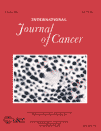Tobacco-specific nitrosamines in smokeless tobacco products marketed in India
Abstract
Smokeless tobacco products are a known cause of oral cancer in India. Carcinogenic tobacco-specific nitrosamines in these products are believed to be at least partially responsible for cancer induction, but there have been no recent analyses of their amounts. We quantified levels of 4 tobacco-specific nitrosamines, N′-nitrosonornicotine (NNN), N′-nitrosoanatabine (NAT), N′-nitrosoanabasine (NAB) and 4-(methylnitrosamino)-1-(3-pyridyl)-1-butanone (NNK), in 32 products marketed currently in India. Levels of nitrate, nitrite and nicotine were also determined. The highest levels of tobacco-specific nitrosamines were found in certain brands of khaini, zarda and other smokeless tobacco products. Concentrations of NNN and NNK in these products ranged from 1.74–76.9 and 0.08–28.4 μg/g, respectively. Levels of tobacco-specific nitrosamines in gutka were generally somewhat lower than in these products, but still considerably higher than nitrosamine levels in food. Tobacco-specific nitrosamines were rarely detected in supari, which does not contain tobacco, or in tooth powders. The results of our study demonstrate that exposure to substantial amounts of carcinogenic tobacco-specific nitrosamines through use of smokeless tobacco products remains a major problem in India. © 2005 Wiley-Liss, Inc.




